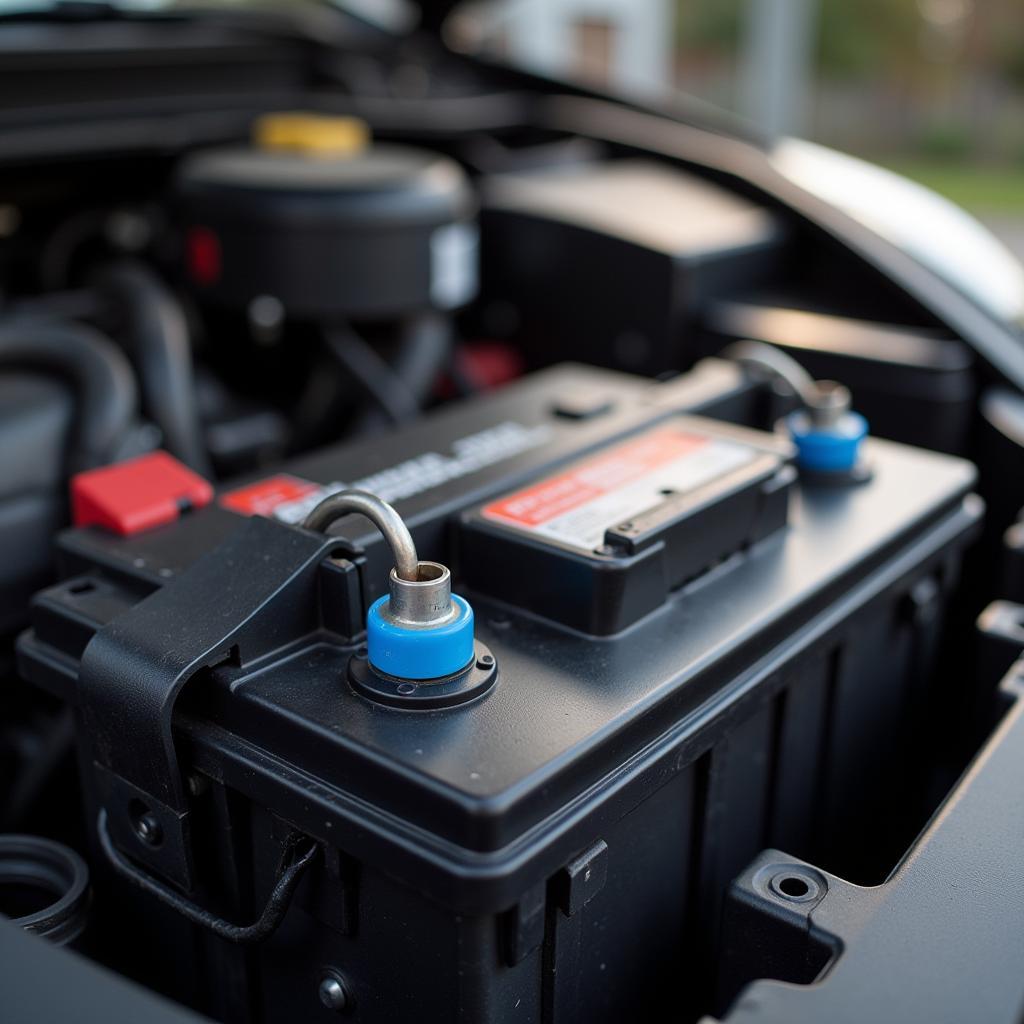Changing a car battery might seem daunting, but with the right tools, it’s a manageable DIY task. Knowing What Tools You Need To Change Car Battery ensures a smooth and safe process. This guide will walk you through the essential tools and safety precautions for a successful battery swap.
 Essential Tools for Car Battery Replacement
Essential Tools for Car Battery Replacement
Gathering Your Arsenal: Essential Tools for the Job
Before you begin, ensure you have all the necessary tools. This will save you time and frustration. Don’t underestimate the importance of having the right equipment.
- Wrench (usually 10mm or 13mm): The most crucial tool. You’ll need this to loosen and tighten the terminal bolts. Make sure you have the correct size to avoid stripping the bolts. A combination wrench is recommended.
- Battery Terminal Cleaner: Corrosion around the terminals can impede the connection. A terminal cleaner, either a wire brush or a specialized tool, is vital for a clean connection.
- Gloves: Battery acid can be corrosive, so protect your hands with a pair of sturdy gloves. Nitrile or latex gloves are suitable.
- Safety Glasses: Always wear safety glasses to protect your eyes from potential sparks or acid splashes.
- Rags or Paper Towels: Keep some rags or paper towels handy to clean up any spills or debris.
- Battery Terminal Puller (Optional): While not strictly necessary, a battery terminal puller can make removing stubborn terminals much easier, preventing damage to the terminals and cables.
- Memory Saver (Optional): Do you need tools to change a car battery? A memory saver, connected to the OBD-II port, can prevent the loss of saved settings in your car’s computer system.
 Mechanic Changing a Car Battery with Correct Tools
Mechanic Changing a Car Battery with Correct Tools
What Size Wrench Do I Need to Change a Car Battery?
The most common sizes are 10mm and 13mm, but it’s always best to check your car’s owner’s manual to confirm the correct size. Using the wrong size can damage the terminals.
Why are Gloves and Safety Glasses Necessary?
Battery acid is corrosive and can cause burns. Safety glasses protect your eyes from splashes, while gloves protect your hands from acid and grime.
Step-by-Step Guide to Changing Your Car Battery
- Park on a level surface and turn off the ignition. Ensure the parking brake is engaged.
- Locate the battery. Usually under the hood, but sometimes in the trunk or under the rear seat.
- Put on your safety glasses and gloves.
- Disconnect the negative terminal first. Use the wrench to loosen the nut and carefully remove the cable.
- Disconnect the positive terminal. Follow the same procedure as with the negative terminal.
- Remove the battery hold-down clamp. This might be a clamp or a strap.
- Carefully lift the old battery out. Avoid tilting it, as it may contain residual acid.
- Clean the battery tray and terminals. Use a wire brush or terminal cleaner to remove any corrosion.
- Place the new battery in the tray. Make sure it’s oriented correctly.
- Install the hold-down clamp.
- Connect the positive terminal first. Tighten the nut securely.
- Connect the negative terminal. Tighten the nut securely.
- Start the car to verify the new battery is working.
 New Car Battery Installed in Engine Compartment
New Car Battery Installed in Engine Compartment
Expert Insights
“A quality recommended tool kit to keep in car should always include the right size wrench for your car battery terminals,” advises John Smith, a seasoned automotive technician with over 20 years of experience. “Don’t rely on adjustable wrenches. They can slip and cause damage.”
“Investing in a best tool set for a car mechanic or even a basic one with the right tools for changing a car battery will save you money and hassle in the long run,” adds Sarah Jones, a certified mechanic specializing in electrical systems. “It’s a simple task that anyone can do with the proper tools and guidance.”
Conclusion
Changing your car battery is a relatively straightforward task if you have the what tools do you need to change car battery. By following these steps and taking the necessary safety precautions, you can save yourself time and money. Remember to always double-check the correct wrench size for your vehicle and never hesitate to consult your owner’s manual.
FAQ
- Can I change a car battery myself? Yes, with the right tools and precautions, it’s a manageable DIY task.
- What happens if I connect the terminals in the wrong order? It can damage the car’s electrical system. Always connect positive first, then negative.
- How do I dispose of my old car battery? Most auto parts stores accept old batteries for recycling.
- How long does a car battery usually last? Typically, 3-5 years, depending on climate and usage.
- What are the signs of a failing car battery? Dim headlights, slow cranking, clicking sounds when starting, and dashboard warning lights.
- What type of battery do I need for my car? Consult your owner’s manual or an auto parts store for the correct battery type and group size.
- What is a memory saver? A device that maintains power to the car’s computer while the battery is disconnected, preventing the loss of saved settings.
Need assistance with car diagnostic or battery replacement? Contact us via WhatsApp: +1(641)206-8880, Email: [email protected] or visit us at 910 Cedar Lane, Chicago, IL 60605, USA. Our customer service team is available 24/7.

Leave a Reply